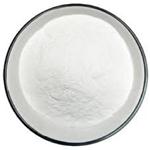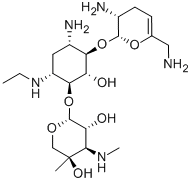- NETILMICIN
-

- $10700.00 / 10Kilograms
-
2024-04-24
- CAS:56391-56-1
- Min. Order: 1Kilograms
- Purity: 99%
- Supply Ability: 100tons
- NETILMICIN USP/EP/BP
-

- $1.10 / 1g
-
2021-06-22
- CAS:56391-56-1
- Min. Order: 1g
- Purity: 99.9%
- Supply Ability: 100 Tons Min
|
| | NETILMICIN Basic information |
| Product Name: | NETILMICIN | | Synonyms: | netilyn;netroymcin;nettacin;4-O-[3α-Amino-6-(aminomethyl)-3,4-dihydro-2H-pyran-2α-yl]-6-O-[4-C-methyl-3-(methylamino)-3-deoxy-β-L-arabinopyranosyl]-N1-ethyl-2-deoxy-D-streptamine;Netilimicin;netilmycin;)-o-(2,6-diamino-2,3,4,6-tetradeoxy-alpha-d-glycero-hex-4-enopyranosyl(1-4))-2;ntl | | CAS: | 56391-56-1 | | MF: | C21H41N5O7 | | MW: | 475.58 | | EINECS: | 260-146-8 | | Product Categories: | | | Mol File: | 56391-56-1.mol |  |
| | NETILMICIN Chemical Properties |
| alpha | D26 +164° (c = 3 in water) | | Boiling point | 575.33°C (rough estimate) | | density | 1.2404 (rough estimate) | | refractive index | 1.7500 (estimate) | | pka | 13.29±0.70(Predicted) |
| | NETILMICIN Usage And Synthesis |
| Description | This is a semisynthetic derivative of sisomicin, which was developed by
ethylation of the 1-N position of the deoxystreptamine ring of
sisomicin . Clinically, netilmicin is used as a sulfate. Netilmicin has a similar
in vitro antibacterial spectrum to that of gentamicin but, unlike
sisomicin, it is active against a proportion of gentamicin-resistant
Gram-negative bacilli. However, netilmicin is not
active against as wide a range of gentamicin-resistant Gram-negative
bacilli as amikacin. Nevertheless, it may be occasionally indicated as
an alternative to amikacin for the treatment of infections caused by
gentamicin-resistant but netilmicin-susceptible Gram-negative organ�isms. The following details apply only to netilmicin | | Originator | Netromycine,Schering,Switz.,1980 | | Manufacturing Process | To a solution of 5 g of sisomicin in 250 ml of water add 1 N sulfuric acid until
the pH of the solution is adjusted to about 5. To the solution of sisomicin
sulfuric acid addition salt thereby formed, add 2 ml of acetaldehyde, stir for
10 minutes, then add 0.85 g of sodium cyanoborohydride. Continue stirring at
room temperature for 15 minutes, then concentrate solution in vacuo to a
volume of about 100 ml, treat the solution with a basic ion exchange resin
[e.g., Amberlite IRA 401S (OH-)], then lyophilize to a residue comprising 1-N�ethylsisomicin.
Purify by chromatographing on 200 g of silica gel, eluting with lower phase of
a chloroformmethanol-7% aqueous ammonium hydroxide (2:1:1) system.
Combine the eluates as determined by thin layer chromatography and
concentrate the combined eluates of the major component in vacuo to a
residue comprising 1-N-ethylsisomicin (yield 1.25 g). Further purify by again
chromatographing on 100 g of silica gel eluting with a chloroform-methanol-
3.5% ammonium hydroxide (1:2:1) system. Pass the combined, like eluates
(as determined by thin layer chromatography) through a column of basic ion
exchange resin and lyophilize the eluate to obtain 1-N-ethylsisomicin (yield
0.54 g).
There is also a fermentation route to netilmicin as noted by Kleeman & Engel. | | Therapeutic Function | Antibiotic | | Antimicrobial activity | It is active against a wide range of
enterobacteria as well as many Acinetobacter, Pseudomonas,
Citrobacter, Proteus and Serratia spp. Staphylococci, including
methicillin-resistant and coagulase-negative strains, are
usually susceptible. Nocardiae are inhibited by 0.04–1 mg/L.
Providencia spp. and anaerobic bacteria are generally
resistant.
It is active against some gentamicin-resistant strains, particularly
those that synthesize ANT(2″) or AAC(3)-I. It exhibits
typical aminoglycoside properties: bactericidal activity at or
close to the MIC; greater activity at alkaline pH; depression of
activity against Pseudomonas by divalent cations; and synergy
with β-lactam antibiotics. Bactericidal synergy can be demonstrated
regularly with benzylpenicillin against viridans streptococci
and E. faecalis, but seldom against E. faecium, which
characteristically synthesizes AAC(6′), to which netilmicin is
susceptible. | | Acquired resistance | It is resistant to ANT(2), AAC(3)-I and AAC(3)-III, but
sensitive to AAC(6). AAC(3)-II confers
resistance, but generally to a lesser degree than to
gentamicin.
Resistance rates are generally about the same as, or a little
lower than, those for gentamicin. | | Pharmacology | Netilmicin is also highly effective with respect to Gram-negative microorganisms (blue-pus
and colon bacilli, rabbit fever, serratia, providencia, enterobacteria, proteus, salmonella, shigella), as well as a few Gram-positive microorganisms (staphylococci and a few strains
of streptococci).
It is used for severe bacterial infections that are caused by microorganisms sensitive to
the drug. Synonyms of this drug are netillin, zetamycin, and others. | | Pharmacokinetics | Cmax 1 mg/kg intramuscular: 4–6 mg/L after 0.5–1 h
2 mg/kg intravenous 30-min infusion: c. 12 mg/L end infusion
5 mg/kg: >10 mg/L after 1 h
Plasma half-life: 2–2.5 h
Volume of distribution: 0.25 L/kg
Plasma protein binding: <10%
The pharmacokinetics are similar to those of gentamicin.
In patients receiving 200 mg (2.2–3.6 mg/kg) intramuscularly
every 8 h for 10 days, a mean peak plasma concentration
of around 14 mg/L was found. Peak concentrations of about
10 mg/L were found in children with pyelonephritis treated
with 5 mg/kg per day, compared with peaks of about 5 mg/L
in children given 2 mg/kg every 8 h. The serum half-life is linearly
inversely related to creatinine clearance in patients with
renal impairment. Plasma concentrations decreased by 63%
during hemodialysis. In older patients with a mean creatinine
clearance of 63 mL/min, the half-life was 6.2 h after a dose of
2 mg/kg.
In the newborn, intramuscular injection of 2.5 mg/kg
produced peak plasma concentrations of 1–5 mg/L 1 h after
the dose, with a plasma half-life of 4 h. In newborns given
6 mg/kg per day, plasma concentrations were 7.4–13.2 mg/L
after 2 h. Half-lives were greater (mean 6.7 h) than in those
of >36 weeks postmenstrual age (mean 4.6 h), and pre-dose
concentrations were 2.1 and 1.6 mg/L, respectively, suggesting
that a lower daily dose (4.5 mg/kg) may be appropriate.
Children with cystic fibrosis had a higher total body
clearance.
Distribution
Netilmicin is distributed in the extracellular water and in
patients with cystic fibrosis the apparent volume of distribution
seems not to be increased.
Very little reaches the CSF even in the presence of inflammation.
Concentrations of 0.13–0.45 mg/L were found in
patients without meningeal inflammation following an intravenous
dose of 400 mg. In patients with meningitis, the drug was
undetectable, although concentrations of 0.2–5 mg/L could be
found later in the course of treatment in some cases.
Excretion
It is excreted unchanged in the urine in the glomerular filtrate,
with some tubular reabsorption. Over the first 6 h, about
50% and by 24 h about 80% of the dose appears. No metabolites
are known and it is likely that this represents binding to
tissues.Clearance on hemodialysis is similar to that reported
for gentamicin. | | Clinical Use | Severe infections (including septicemia, lower respiratory tract infections,
urinary tract infections, peritonitis, endometritis) caused by susceptible
strains of Gram-negative bacilli and staphylococci | | Side effects | It is considered to be less nephrotoxic than gentamicin, a
difference not easily explained since the renal clearance and
renal and medullary concentrations of the drugs appear to
be similar. Both vestibular and cochlear toxicity appear to be
low and vestibular toxicity without audiometric abnormality
is rare. In some patients, plasma concentrations up to
30 mg/L over periods exceeding 1 week have not resulted in
ototoxicity. Evidence of some renal toxicity in the excretion
of granular casts has occurred fairly frequently in patients receiving 7.5 mg/kg per day, and is more likely to occur
in the elderly and in those receiving higher doses or longer
courses. In patients treated for an average of 35 days
with 2.4–6.9 mg/kg per day, there was no effect on initially
normal renal function, even in the elderly. Long-term treatment
led to an increase in elimination half-life from 1.5 to
1.9 h. Nephrotoxicity has been observed in some diabetic
patients. Overall estimates of the frequency of nephrotoxicity
have ranged from 1% to 18%. Increases in serum
transaminase and alkaline phosphatase concentrations have
been seen in some patients without other evidence of hepatic
impairment.
Once-daily dosing is thought to be safer than twice or three
times daily dosing. | | Synthesis | Netilmicin, O-3-deoxy-4-C-methyl-3-(methylamino)-β-L-arabinopyranosyl
(1→4)-O-[2,6-diamino-2,3,4,6-tetradeoxy-α-D-glycero-hex-4-enopyranosyl]-(1→6)-
2-deoxy-N3
-ethyl-L-streptamine (3.4.10), is also a semisynthetic antibiotic that is synthe�sized in two stages from another known antibiotic, sisomicin (3.4.11), which is produced
by a culture of M. inyoensis. In the first stage of synthesis, reacting sisomicin with
acetaldehyde in a specific acidic medium of pH 5 is successful in selectively giving an
imine at the 3-amino group of the 2-deoxystreptamine region of the molecule. The result�ing imine is then hydrogenated by sodium cyanoborohydride to an ethylamino derivative
—netilmicin (32.4.12). | | Drug interactions | Netilmicin is inactivated less than gentamicin and tobramycin by high
concentrations of various penicillins .
At the highest penicillin concentration studied (500 mg/ml), inactiva�tion of netilmicin was a little higher than amikacin. The in vivo
inactivation of netilmicin was compared with gentamicin in patients
with end-stage renal disease. The terminal
elimination half-life for gentamicin decreased from 60 to 25 hours,
whereas the values for netilmicin remained essentially the same at 42
to 40 hours. Such patients receiving combinations of netilmicin and
various penicillins will not require further dose adjustment.
Netilmicin differed from other aminoglycosides by reducing T3 or
triiodothyroxime levels in serum. |
| | NETILMICIN Preparation Products And Raw materials |
| Raw materials | Sodium cyanoborohydride-->Sisomicin-->Sulfuric acid-->Acetaldehyde-->D-Streptamine, O-2,6-bis(acetylamino)-2,3,4,6-tetradeoxy-α-D-glycero-hex-4-enopyranosyl-(1→4)-O-[3-deoxy-4-C-methyl-3-(methylamino)-β-L-arabinopyranosyl-(1→6)]-N3-acetyl-2-deoxy-N1-ethyl- (9CI)-->D-Streptamine, O-2,6-bis(acetylamino)-2,3,4,6-tetradeoxy-α-D-glycero-hex-4-enopyranosyl-(1→4)-O-[3-deoxy-4-C-methyl-3-(methylamino)-β-L-arabinopyranosyl-(1→6)]-N3-acetyl-2-deoxy- |
|